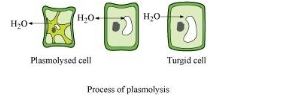(a) With the help of well-labelled diagrams, describe the process of plasmolysis in plants, giving appropriate examples.
(b) Explain what will happen to a plant cell if it is kept in a solution having higher water potential.
(a) Plasmolysis can be defined as the shrinkage of the cytoplasm of a plant cell, away from its cell wall and toward the centre. It occurs because of the movement of water from the intracellular space to the outer-cellular space. This happens when the plant cell is placed in a hypertonic solution (i.e., a solution having more solute concentration than the cell cytoplasm). This causes the water to move out of the cell and toward the solution. The cytoplasm of the cell shrinks and the cell is said to be plasmolysed. This process can be observed in an onion peel kept in a highly concentrated salt solution.

(b) When a plant cell is placed in a hypotonic solution or a solution having higher water potential, the water diffuses into the cell (i.e., movement is observed from higher to lower water pressure region). The entry of water in the plant cell exerts pressure on the rigid cell wall. This is called turgor pressure. As a result of its rigid cell wall, the plant cell does not burst.
Click here to get exam-ready with eSaral
For making your preparation journey smoother of JEE, NEET and Class 8 to 10, grab our app now.
